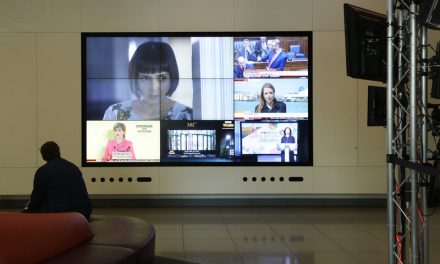Reviewing methods used by earlier generations to challenge discriminatory acts in television hiring practices provides proof of the long-standing battle between those who worked to challenge barriers to entry for Black people and the already established media companies that are more concerned about profit margins. Like many other established business policies, enforced diversity in the American workplace begins not with revenue but within government policy. In 1945, President Harry Truman advanced the cause of diversity in the American workplace by commissioning the Committee on Civil Rights (MacDonald, 1983). While Truman did not believe in social equality, he separated his personal feelings from his political agenda. (McCullough, 1992). Truman understood the importance of Black advancement to the Democrats and his political career (Forman, 2007). This policy set the stage for future attempts by politicians and industry to court Blacks for political and economic reasons.
One attempt was a public relations initiative NBC began that took advantage of the developing African American market. NBC was set on surpassing its competitors’ efforts by updating its racial policies. The network wanted to be seen as the leader in integrating Blacks in television. With the growing Black middle class, NBC wanted this group as viewers and consumers. An estimated US$15 billion market was available (Stole, 1996). The network had a set of objectives, including opening television and radio airwaves to Black entertainers; making sure that these consumers were not offended by the network’s practices; earning the goodwill of Black leaders; and developing a closer relationship with Black communities. (Forman, 2007).
Being the first national television network that hires Blacks in positions in front of and behind the scenes could result in brand loyalty and, consequently, higher ratings. In 1950, however, out of approximately two thousand employees, NBC employed a mere thirty-five Blacks, mostly in clerical and custodial areas (Forman, 2007). This attempt was a balancing act as NBC also needed to keep from offending those racist White viewers who were still an important commodity.
Many Southern Whites protested the racial integration on their televisions. For example, Governor Talmedge of Georgia threatened to boycott TV show sponsors’ products if Whites and Blacks conversed on television as equals (MacDonald, 1983). Many executives at the networks and local stations also felt racial prejudice toward Black people. Their desire for increased profit and an expanded audience superseded those feelings. How, then, could they attract the Black audience? NBC contracted public relations specialist Joseph Baker to help.
Baker was considered an authority on African American life and “an effective and savvy professional with an apparent capacity to navigate elite executive boardrooms and local political backrooms with equal ease” (Forman, 2007, p. 125). His PR firm, Joseph V. Baker and Associates worked with industry titans such as US Steel, DuPont Corporation, and American Tobacco (Forman, 2007).
One of Baker’s first acts was to revise NBC’s standards and practices policy, requiring issues of race, color, creed and national origin be dealt with dignity and respect (Pondillo, 2010). He demanded access to the NBC Vice Presidents, which strengthened his influence within NBC (Forman, 2007). Baker also created the RCA Baton, a newsletter that celebrated Black employees and featured radio and television programs with Black cast members (Forman, 2007). Additionally, Baker put together roundtable discussions with the Black press and NBC executives to discuss NBC’s hiring practices and its portrayal of Black people.
Baker’s successful campaign led to NBC executives using Baker for all race-based issues, almost as a scapegoat. When William Brooks, Vice President of Public Relations, was asked about questionable lyrics regarding Black people on an NBC show, he replied, “I am very glad that we have Joe Baker because we can put a lot of these things in his lap now… if anybody questions us, then we say that Mr. Baker advised us along this line” (Forman, 2007). Baker’s job as a Special Counsel was intentionally segregated from the organization. As a for-hire consultant, NBC could benefit from this “diversity hire” without adding an employee to its permanent staff (Collins, 1997; Ray, 2019).
A significant contribution made by Joseph Baker to NBC’s policy is the development of its Integration without Identification policy. This policy cast Black people in television roles, quietly including them in non-domestic roles (Forman, 2007). Because of Integration without Identification, actors were hired for roles that reflected jobs that Blacks had in real life (Pondillo, 2010). Once established, the policy was an overwhelming success for NBC. It helped that simultaneously, rival CBS had to deal with adverse reactions to their TV program Amos ‘n’ Andy (Forman, 2007).
Despite his success, Baker’s tenure with NBC ended abruptly in 1953. Ultimately, the Black press accused him of selling out. They did not like being segregated by Baker from the general press into separate press conferences and, as a result, felt silenced. The press also criticized NBC executives because they were not as accessible to them. When there was a success, NBC embraced Baker as a colleague. As he fell out of favor, Baker discovered no loyalty within the network. As an independent contractor, NBC could easily discard him and his ideas.
NBC was ambivalent about hiring Black people in respectable roles. Following up its Integration without Identification policy with actual employment opportunities would potentially bring about too much integration, which could alienate its sponsors and its Southern audience. Advertisers held tremendous power over the TV programs they sponsored. In the early 1950s, advertiser-sponsored programming was still standard (“1950s TV Turns,” 2005). The power that these sponsors had over TV producers was immense because if they disapproved of the storylines, characters, or even dialogue, the advertisers could remove their money from the show. At the time, there was no financial benefit for the network to target any other audience beyond the White one. The struggle for increased diversity in broadcasting has long been an issue. Despite efforts in the early era of television, the prevailing attitudes about Black people were too strong to overcome. The racialized systems established in broadcast networks reflected the opinions in society.
Now, decades later, there are broadcast initiatives to increase diverse representation in television. NBC currently has multiple programs that address diversity and inclusion at the network. Despite advances, there has been “virtually no progress in diversifying the studio and network suites whose greenlighting decisions set the parameters by which everything else evolves” (Hunt and Ramòn, 2021, p. 70). As a racialized organization, NBC and the other networks still have their work cut out for them to confront the inherent racial bias at the executive level. Developing and applying a racialized media policy paradigm to assess these efforts is needed to move forward. Those groups in the 1940s could not imagine how far broadcasting has come. Each effort made by these initiatives moves broadcast programming closer to the diversity we deserve, with representation for all people in front of and behind the scenes.
Leah P. Hunter is an Assistant Professor at Florida A&M University in the School of Journalism & Graphic Communication. This blog entry is part of a longer chapter analyzing NBC’s attempts at diversity in the 1940s and 1950s found in the book Racializing Media Policy, Jason A. Smith and Richard T. Craig, editors. Leah has authored and co-authored publications on media diversity and policy, assessment, and student achievement. She has published chapters on Tyler Perry’s manipulation of his core audience in The Problematic Tyler Perry, the viability of Bounce TV in Race and Contention in 21st Century US Media, and sister circles in social media in Black Sisterhoods.
References
“1950s tv turns on America,” (2005, March 28). Ad Age. Retrieved from: http://adage.com/article/75-years-of-ideas/1950s-tv-turns-america/102703/.
Collins, P. H. (2002). Black feminist thought: Knowledge, consciousness, and the politics of empowerment. Routledge.
Forman, M. (2007). Employment and blue pencils: NBC, race, and representation, 1926-55. In M. Hilmes (Ed.), NBC America’s network (pp. 117-134). Berkley and Los Angeles, CA: University of California Press
Hunt, D. and Ramon, A. (2021). Hollywood diversity report 2021: Pandemic in progress. Part 2: Television. UCLA College of Social Sciences.
MacDonald, J. F. (1983). Blacks and white TV: Afro-Americans in television since 1948. Chicago: Nelson-Hall Publishers.
McCullough, D. (1992). Truman. New York: Simon and Schuster.
Pondillo, R. (2010). America’s first network TV censor: The work of NBC’s Stockton Helffrich. Carbondale and Edwardsville: Southern Illinois University Press.
Ray, V. (2019). A theory of racialized organizations. American Sociological Review, 84(1), pp. 26-53. https://doi.org/10.1177/0003122418822335.
Stole, I. (1996). Nat King Cole and the politics of race and broadcasting in the 1950s. The Communication Review, 1(3), pp. 349-371. https://doi.org/10.1080/10714429609388269.






